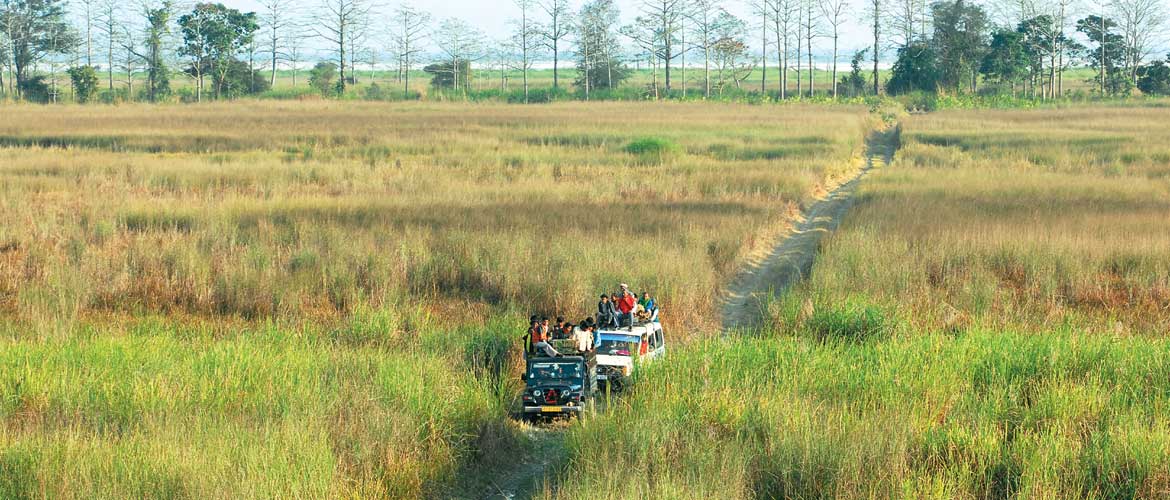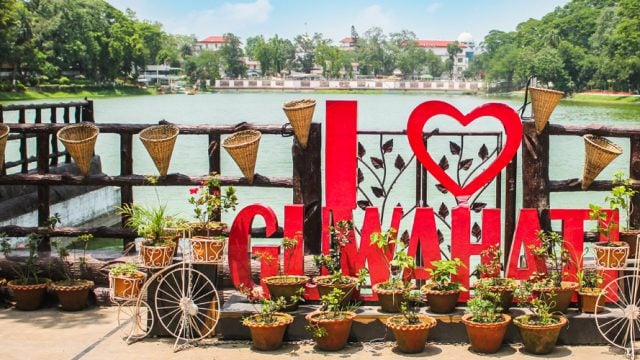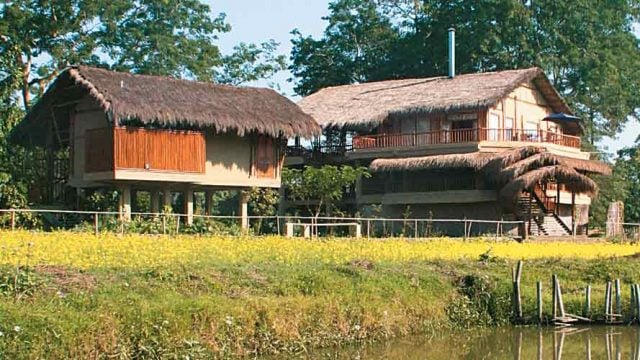Orang is a quick drive from Guwahati. Quick, except the last 12-odd km
A rather unkempt mixture of tall trees and high grass flank an unexpectedly smooth forest track. Every now and then, a curious Indian hog deer peeps from behind the bushes and stares at the visitors. Suddenly, there is a rustle and a wild boar dashes into the bushes, frightening a mob of deer. The moment makes for an excellent photograph.
A kilometre ahead, the well-located but rundown Satsimulu Inspection Bungalow overlooks a swampy grassland where rhinos congregate. Further on, there is a pond and an old Shiva temple beside it. Around the temple are dirt tracks used by rhinos and elephants. The temple is a great point for wildlife sighting and photography. Tour guides suggest that tigers, however, do not venture in these open areas. They roam around in the more dense portions of the forest.
About Rajiv Gandhi Orang National Park
Legend has it that centuries ago, this swampy woodland was home to the Orang tribe, who deserted this land after being hit by a fatal disease. In 1915, the forest area in Orang city was declared a game reserve, and in 1998, a wildlife sanctuary. In 1999, it was made a national park. There are 26 man-made ponds here, which substantiate the belief that this region was inhabited by a group of people. Of these ponds, a few still collect rainwater, but the rest have dried up. Historians suggest that the Shiva temple could also have been built by the same community.
Orang’s terrain is similar to that of Kaziranga – swampy grassland with landlocked beels (wetlands) and slightly higher woodlands stretching away from the river. There are 12 existing beels in Orang, some of which are homing grounds for thousands of migratory birds that gather here in winter.
Entry Indians ₹ 50; Foreigners ₹ 500 Vehicle fee ₹ 300 Timings Sunrise–sunset Photography Indians ₹ 500; Foreigners ₹ 5,000 Videography Indians ₹ 1,000; Foreigners ₹ 10,000 Guide fee none. The forest guard accompanying you into the park doubles up as your guide. A generous tip is welcome
Tip Remember to carry medicines, a torch, binoculars and warm clothes
Rajiv Gandhi Orang National Park is located on the north bank of the Brahmaputra river. It is only 78.8sq km in area, and stretches across Udalguri and Sonitpur districts.

The terrain slopes down gently from north to south and is fringed by the Dhunseri river in the west and Pasnoi river in the east. All the streams that run through the park drain into the Brahmaputra in the south. Only a section of the park is accessible by a dirt track. Forest personnel use elephants to patrol the extended areas of the forest. Camps set up by tourists are visible after every few kilometres in the motorable areas. You can choose to bring your own vehicle or sign up for a jeep safari, arranged by the forest department.
Things to See & Do
Orang is an ideal getaway for those looking for a quiet, yet adventurous location. The local authorities are helpful and eager to promote tourism in the park. The infrastructure is basic, but a short stay at the Satsimulu Bungalow can be quite rewarding. Elephant and rhino sightings are aplenty. There is a good chance of spotting tigers too. Orang is, in fact, known as one of the best places to spot a tiger in Assam. One will not be disappointed in watching birds either as there are about 200 species of the winged creatures.
Spotting Wildlife
Safaris are without a doubt, inevitably rewarding in this national park. Besides the one-horned rhino, tiger, wild elephant, Indian hog deer and wild boar, there are several snakes here too, such as the viper, krait, cobra and python.

Birds and Butterflies
Home to about 200 bird species including the heron, Bengal florican, pelican, bittern, owl, stork, eagle, lapwing, drongo, barbet, sandpiper, kingfisher, shrike, oriole, babbler, golden eagle and rice skipper, the national park is a fabulous destination for birdwatching.

There are also scores of butterflies here, which make for excellent subjects of photography. Do not forget to bring your binoculars and camera.
Elephant Rides
Arranged by the forest department, elephant rides are the best way to explore the national park. As much of the forest is not connected by tracks, jeep safaris are unable to take you deep inside the wilderness.
Fee ₹ 300 per person per hour Timings Morning and evening
There is an elephant training camp on the bank of the Pasnoi river, where young elephants are trained and looked after.
Cruising
For those wishing to explore the national park a little differently, the Assam Bengal Navigation Luxury Cruise arranges trips on the Brahmaputra river. Tourists board the cruise on one end of the park and go up and down the full length of the river along the national park. The forest department picks tourists from a designated point and takes them around the park.
This arrangement has given Orang a real fillip. Officials feel that with the new focus, they will slowly be able to contribute enough to the exchequer to feature as one of Assam’s mainline national parks.
Where to Stay & Eat
Stay at Assam Tourism’s Prashanti Tourist Lodge (Cell: 09854165351, 09954023413; Tariff: ₹ 1,000–2,000) near the Park Gate. The lodge has AC rooms, a restaurant and other facilities and arranges jungle safari.
You may also opt to stay at Tezpur, about an hour’s drive away.
Around Rajiv Gandhi Orang NP
A trip to Orang would specifically be for wildlife as there is not much else to see here. En route, about 35 km away from Guwahati are the Madan Kamdev temple ruins, also called the Khajuraho of Kamrup.
In the vicinity of this temple, are other excursions to a silk-weaving village called Sualkuchi, the Pua-Mecca Mosque in Hajo and the Hayagriba Madhav Temple. Travelling eastwards from Orang would take you to Tezpur and from thereon to Nameri National Park and, if you have the time, further on to the rugged mountains and monasteries of Tawang in Arunachal.
Other sanctuaries around the River Brahmaputra’s north bank are Sonai Rupai Wildlife Sanctuary, Sonar Wildlife Sanctuary, Eagle’s Nest Wildlife Sanctuary and Pakke National Park. Note that prior preparation and permission are required for visiting all of the above, except Nameri National Park.
All these places require a hired vehicle for transport, and preferrably a local guide. The terrain is bumpy and SUVs would be the best option to travel. Buses are available but they are very time-consuming. A good option is to rope in the services of a tour operator. A reliable one is Assam Bengal Navigation.
The Brahmaputra River Cruise
If you’re looking for a different way to go about a wildlife holiday and can afford it, the Charaidew, a luxury cruise boat on the Brahmaputra, is your answer. This chic, air-conditioned boat has well-appointed, comfortable cabins, attached bathrooms, open decks, a dining room with exceptional meals and a bar-cum-sitting area that offers reading material, board games, and a telescope for birdwatching.
With this as your travel base, you have different itineraries on offer (seven-day trips or two-week trips, detailed down to the exact sailing dates), which apart from offering you glimpses of the state’s culture, history and craft, also take you to four of Assam’s national parks: Manas, Orang, Nameri and Kaziranga. If you have the time, you can also put in a trip to the world’s largest inhabited river island, Majuli, situated 200km east of Guwahati.

Apart from the luxury service of the boat itself – the tour includes experiencing every wilderness on both sides of the Brahmaputra. The trip to the Manas National Park includes a night’s stopover at a select jungle lodge, but all others are day-trips that wind up back in the boat for the night. The guided tour of Orang and the other parks offers elephant and jeep safaris as part of the package. On some evenings, the Charaidew moors at secluded sand banks, bonfires are conjured up and local village music and dance troupes perform for a while on the pristine sands. You could start your day with the call of wild ducks as you sip your morning tea, feast on various culinary spreads at different intervals, take a trip to the shore (including plenty of wildlife sighting) and then head back to a relaxed evening of luxury on the boat.
The Charaidew, India’s first real long-haul luxury river cruise, has not only opened up a whole new dimension to holidaying in the Northeast but has also generated employment opportunities and given an impetus to tourism-linked processes in the region. The elegant interior of the boat is finely done with locally sourced bamboo; all furnishings sourced from women weavers while most of the boat’s efficiently trained and pleasant staff are young people from local villages. So while the cruise may seem a little high-end in most ways, it does have some real benefits filtering back down to earth.
Information
Cruise tariff US$195, 295 and 395, or INR equivalent, per person per day, inclusive of all charges, like meals and park entry fee. For more details, call 0361-2667871/ 73, or see assambengalnavigation.com
Fast Facts
When to go November–April
Wildlife/ Forest Dept offices
Assam Tourism
Tourist Information Centre
Station Road
Guwahati
Tel: 0361-2547102, 2544475
assamtourism.gov.in
Divisional Forest Officer
Mangaldai Wildlife Division
Mangaldai, Darrang
Tel: 03713-230020, 230708
STD code 03712
State Assam
Location On the north bank of the Brahmaputra river, stretching across Udalguri and Sonitpur districts
Distance 64km W of Tezpur
Route from Tezpur NH37A and NH52 to Orang city via Bihuguri and Sirajuli
Tip Accommodation in the park can be booked through DFO, Mangaldai
Getting There
Air Nearest airport: Salonibari Airport at Tezpur (58km/ 1hr/ ₹ 1,500) or LGBI Airport at Guwahati (160km/ 3hrs/ ₹ 3,500). Air India operates flights from from Silchar and Kolkata to Tezpur. Guwahati is connected to all important cities of India by major airlines
Rail Nearest railhead: Guwahati Railway Station is connected to most cities of India by several daily trains
Road The park is well-connected by roads to nearby towns in Assam. It is 15km off a smooth highway (erstwhile NH52) connecting Guwahati to Tezpur via Mangaldai Bus There are many buses from Guwahati to Tezpur, which stop at the Orang turnoff on the main road, 26km away from the park. Jeeps are available from the turnoff to cover the entire circuit. But it is best to hire a car from Guwahati or Tezpur
Dipankar Ghose
East Zone
India





